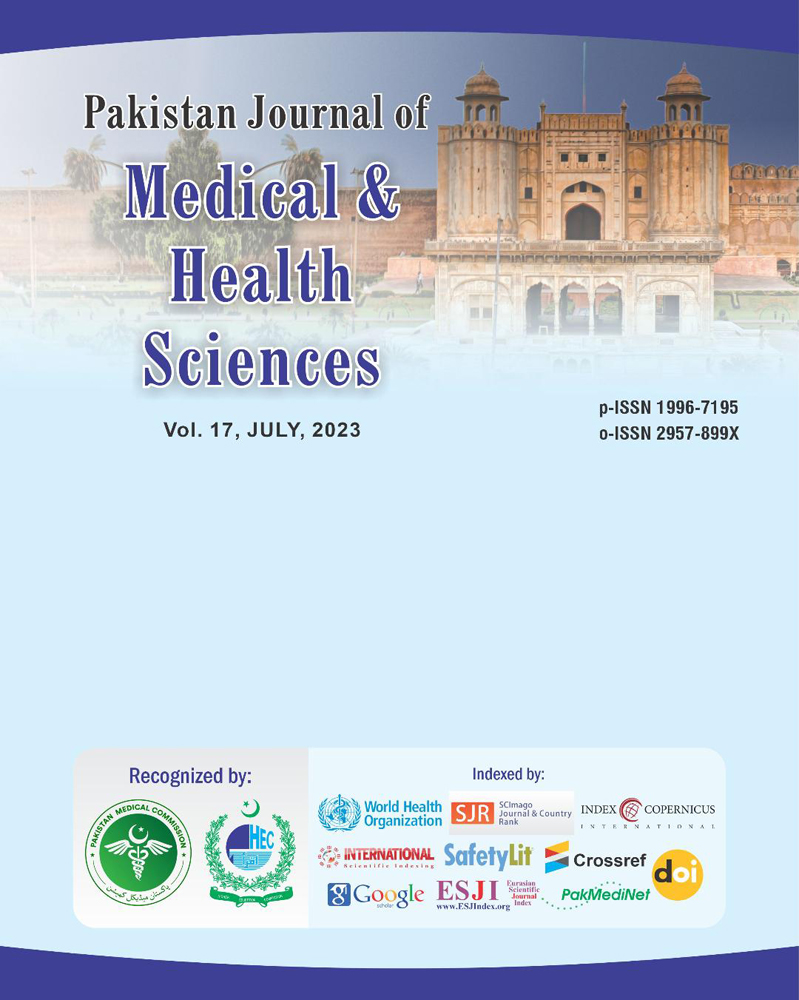Surgical Resection and Reconstruction Outcomes in Soft Tissue Sarcomas: A Plastic Surgery Perspective on Complications, Recurrence, and Survival
DOI:
https://doi.org/10.53350/pjmhs202317759Abstract
Background: In general population adults and children are most frequently effect by Soft tissue sarcomas. About 90 various histological subtypes of soft tissue sarcoma were recently recognized.
Objective: The objective of this study was to evaluate the outcomes of surgical resection as well as reconstruction among individuals with various soft tissue sarcoma histological subtypes, with an emphasis on the issues, recurrence rates, and overall survival.
Methodology: This current study was carried out at the department of surgery, Avicenna Hospital, Lahore and Mardan Medical Complex, Mardan for a period of six months from October 2022 to March, 2023, after taking permission from the ethical boards of the hospitals. A total of 20 individuals were included in this study. The inclusion criteria for this study were histologically confirmed STS diagnosis and treatment at our facility. Individuals with a clinical history of pain and redness in any part of the their body swelling that gradually increased in size, or solid masses originating within deep sub-facial planes, were initially evaluated with an X-ray to rule out bony tumors, followed by an MRI with contrast. Following a suitable imaging examination, the conventional diagnostic approach was performing several core needle biopsies (with needles larger than 16G). Participants with soft tissue sarcoma were included in the study. Results of soft tissue sarcoma removal and repair among individuals with various histological subtypes, with an emphasis on overall survival, recurrence rates, and comorbidities. The statistical analysis was conducted using SPSS version 23.0.
Results: A total 20 individuals participated in the current study out of which 11(55%) were male and 9(45%) were female. 14(70%) were married and 6 (30%) were unmarred individuals Three patients were found to have sarcomas of the soft tissues of the scalp and three of the arms, four participants had forearm sarcoma, 4 had abdominal sarcoma, 4 had lower limb sarcoma, and one individuals possessed STS at the nape of the thigh. Histopathological analysis showed that the most common subtypes of ST S were pleomorphic sarcoma, liposarcoma, and leiomyosarcoma. Latissimus dorsi muscle was the most often employed flap, with 8 patients using it, 4 patients using radial forearm free flap, 2 patients using vertical rectus abdominis my cutaneous (VR AM) flap, and 2 patients using a free anterior lateral thigh (ALT) flap to rebuild their deformity. In four individuals, a musculocutaneous gastrocnemius flap was utilized for repair. Twelve months was the median follow-up period. Six out of twenty patients who received flap reconstruction experienced complications (two patients experienced complete Flap failure, two patients experienced seroma, and two patients experienced infection). The survival rate was 19 (95%) and the recurrence rate was 6 (30%).
Conclusion: According to the study's findings, surgical resection followed by immediate soft tissue repair has aided in the management of these complicated patients by lowering the risk of complications and recurrence.
Keywords: Surgical resection; Complications; Soft tissues
Downloads
How to Cite
Issue
Section
License
Copyright (c) 2023 Irfan Ishaq, Asghar Ali, Zahid Iqbal Bhatti, Hafiz Waqas Ahmed, Naveed Ahmad Khan, Mufassar Nishat

This work is licensed under a Creative Commons Attribution 4.0 International License.


